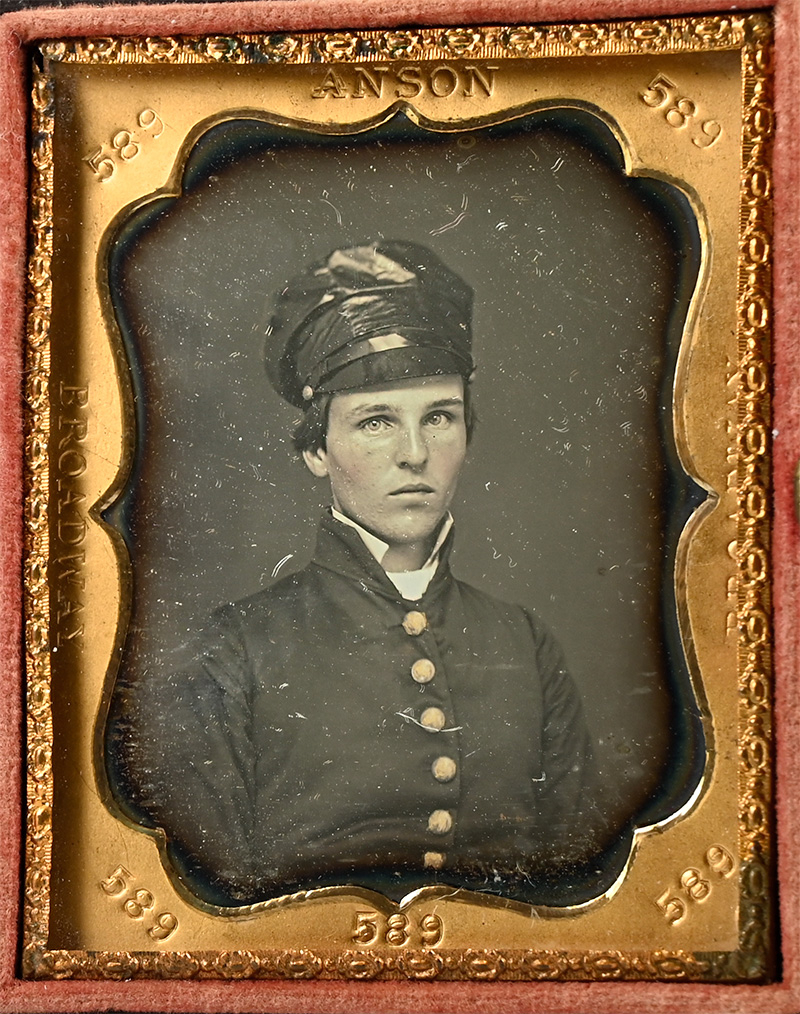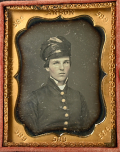site search
online catalog
CONFEDERATE GENERAL LUNSFORD LINDSAY LOMAX AS A WEST POINT CADET IN DAGUERREOTYPE BY ANSON CA. 1854/55, EX-BILL TURNER COLLECTION

$9,500.00
Quantity Available: 1
Item Code: 1138-1905
Formerly in the collection of Virginia collector and dealer Bill Turner this ninth plate cased daguerreotype by Rufus Anson of New York City is extremely clear, nicely cased, has a mat showing the photographer’s name and address, and shows later Confederate General Lunsford Lindsay Lomax as a West Point cadet in his furlough uniform, likely in 1854 or 1855.
Born in Rhode Island, Lomax (1835-1913) was the son of Mann Page Lomax, a U.S. Army officer and member of one of Virginia’s “First Families.” He was appointed to the U.S. Military Academy “at large,” entering 1 July 1852 and graduating 21st in his class in 1856. As usual with graduates at the time he was made a brevet 2nd lieutenant, awaiting a regular commission, and to the newly formed Second U.S. Cavalry 1 July 1856, transferring to the 1st U.S. Cavalry as a full 2nd Lieutenant Sept. 30. He Served at the Cavalry School for Practice, Carlisle, Pa., 1856‑57; on frontier duty at Ft. Leavenworth, quelling Kansas Disturbances, 1857; on the Cheyenne Expedition, 1857, being engaged in the Combat at Solomon's Fork of the Kansas, July 29, 1857, and posted to Ft. Leavenworth. He was scouting in 1857 and engaged against the Kiowa and Comanche Indians in a Skirmish near Grand Saline, Kan., Aug. 6, 1857, then posted to Ft. Riley and involved again in quelling “Kansas Disturbances,” 1857‑58. He was on the march to Ft. Kearny, Neb. In 1858, and at Ft. Arbuckle, Indian Territory, 1859. He was at Ft. Cobb, CO, 1859‑60 and on the Kiowa and Comanche Expedition, 1860, being engaged in several Skirmishes, June to Sep., 1860. He was promoted to 1st Lieutenant and on leave of absence in 1861, but resigned his commission to go south on April 25.
In this photograph he appears from the lower chest up, turned slightly, but looking directly into the lens. He wears the simple cadet’s furlough uniform consisting of a blue frock coat with no rank insignia, but brass buttons, which have been lightly tinted by the photographer. A tall white shirt collar shows at his neck, his cheeks have been delicately tinted, and he wears a cadet forage cap with a waterproof raincover, pushed back slightly so as not shade his face. Cadets were normally allowed leave only after completing their second year, which would date likely date the image to 1854 or 1855, before his graduation and in keeping with Anson’s address on the mat.
After resigning from the U.S. Army, Lomax was appointed from Virginia to the C.S, Cavalry as 1st Lieutenant in May 1861, with rank from March 11. There is some thought he may have served for a time on Johnston’s staff, but in August 1861 he was ordered to Arkansas, where he served on McCulloch’s staff as Adjutant General, apparently ranking as Captain. After McCulloch’s death in March 1862 he served on Van Dorn’s staff as Assistant Adjutant and Inspector General making Lt. Colonel in April, with a brief stint as Ordnance Officer on Hebert’s brigade staff. In March 1863 was transferred back east to be Colonel of the 11th Virginia Cavalry, seeing action at Gettysburg and being promoted to brigadier general in Fitz Lee’s division as of July 23. He was active in the fighting against Grant in the Virginia campaign of 1864 and in August was promoted to Major General and served under Early in the Valley, commanding the Valley District at the end of the war.
One of his largest contributions to the southern war effort was behind the scenes: Mosby credited him with the improvement of Confederate scouting and intelligence work in Valley and in Loudon County through the organization, training and use of partisan rangers, supplying needed expertise in such gentle arts as tapping telegraph wires and destroying trains. After the destruction of Early’s forces in the Shenandoah Lomax saw further service with Johnston, with whom he surrendered in North Carolina.
After the war Lomax turned to farming in Virginia, but also served as President of the VA Agricultural and Mechanical College, helped assemble and edit the Official Records of the war, and served as a commissioner of the Gettysburg battlefield park before his death in 1913.
The image is housed in a figural thermoplastic showing children chasing butterflies. The case is in excellent condition and retains its velvet facing pad. The scalloped mat is prominently stamped “ANSON” at top center and “589” at the corners indicating Rufus Anson’s address on Broadway in New York City starting in 1853. This agrees with the likely date of the portrait given the Academy’s policy on cadet leave, and perhaps points to an earlier rather than later date if the repeated address stamp was meant to emphasize a new location. Lomax’s papers are at UNC and might provide and even tighter dating. There is just a narrow solarization band around the scalloped inner edges of the mat.
Lomax is a very interesting figure with very active service in the regular army on the plains before the war, in the troubles in Kansas leading up to the war, and in the western and eastern theatres during the conflict. [sr] [ph:m]
~~~~~~~~~~~~~~~~~~~~~~~~~~~~~~~~~~~
THIS ITEM, AS WITH ALL OTHER ITEMS AVAILABLE ON OUR WEB SITE,
MAY BE PURCHASED THROUGH OUR LAYAWAY PROGRAM.
CLICK HERE FOR OUR POLICIES AND TERMS.
THANK YOU!
Inquire About CONFEDERATE GENERAL LUNSFORD LINDSAY LOMAX AS A WEST POINT CADET IN DAGUERREOTYPE BY ANSON CA. 1854/55, EX-BILL TURNER COLLECTION
For inquiries, please email us at [email protected]
Most Popular
Historical Firearms Stolen From The National Civil War Museum In Harrisburg, Pa »
Theft From Gravesite Of Gen. John Reynolds »
Cavalry Carbine Sling Swivel »
Fine Condition Brass Infantry Bugle Insignia »
featured item
US PATTERN 1858 SMOOTHSIDE CANTEEN IDENTIFIED TO 13TH PENNSYLVANIA VOLUNTEERS
The body of this canteen is covered in a very nice conditioned sky-blue cloth and is strongly stenciled on one side with “13” over “PV” done in white paint. The cover is solid with no signs of moth damage or seam separations. The edges of the… (490-4680). Learn More »






